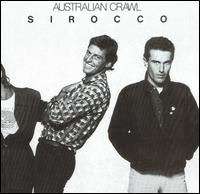Sirocco (album)
Sirocco is the second album from Australian rock band Australian Crawl. It was released in July 1981 and on 3 August, it topped the Australian charts where it remained for six weeks, the band's first of two albums to hit #1.[2] It was released a year after their successful debut The Boys Light Up which had reached #4.[2]
| Sirocco | ||||
|---|---|---|---|---|
 | ||||
| Studio album by | ||||
| Released | July 1981 | |||
| Recorded | March–April 1981 | |||
| Studio | EMI Studios 301 | |||
| Genre | Pop rock | |||
| Length | 46:07 | |||
| Label | EMI Australia | |||
| Producer | Peter Dawkins | |||
| Australian Crawl chronology | ||||
| ||||
| Singles from Sirocco | ||||
| ||||
| Review scores | |
|---|---|
| Source | Rating |
| Allmusic | |
The album was recorded in March–April 1981 in Sydney, New South Wales and produced by Peter Dawkins (Air Supply, Billy Thorpe, Dragon, John Farnham).[3]
"I was approached by Australian Crawl, who were about to do their second album, Sirocco. They’d been tortured to death by David Briggs, or at least by his studio style, and needed a change. We got along incredibly well, it was all so comfortable. They played me twenty new songs, I gave them a list of the eleven I liked and we just said let’s go."[4]
Sirocco spent eight months in the Top 20[2] and was their most successful album.[5] 1981 Australian End of Year Album Charts has Sirocco at #2 behind Double Fantasy by John Lennon and ahead of AC/DC's Back in Black making it the best charting album by an Australian act.[2][6]
The album was named after Australian born actor Errol Flynn's yacht and included the second single from the album, a lyrical biography, called "Errol".[5][7] Sirocco was the Crawl's first US and European release.
Drummer Bill McDonough's younger brother Guy McDonough (co-lead vocals, rhythm guitar) had joined as their sixth member.[8] Guy had already co-written tracks for their first album and now wrote or co-wrote five of Sirocco's eleven tracks including all three singles; he also provided lead vocals: "Errol" and "Oh No Not You Again".[7] "Errol" was voted their third most popular song by listeners of Triple M in 2007.[9] The other single from the album was "Things Don't Seem" which reached #11[7] and was their fifth most popular song in the 2007 poll.[9]
Sean Higgins was a bandmate with the McDonough brothers in an earlier band, The Flatheads,[8] and had co-written "Downhearted" for Boys Light Up; Higgins co-wrote "Things Don't Seem" for Sirocco. At about this time guitarist Brad Robinson was married to actress Kerry Armstrong, later an Australian Film Institute Award winner,[10] and they co-wrote "Easy On Your Own", which was also the B-side to "Errol".
Track listing
- "Things Don't Seem" (Guy McDonough, Sean Higgins) - 3:57
- "Unpublished Critics" (James Reyne, Paul Williams) - 5:14
- "Love (Beats Me Up)" (Reyne) - 4:35
- "Oh No Not You Again" (G McDonough) - 5:08
- "Lakeside" (Reyne) - 4:49
- "Trusting You" (William "Bill" McDonough, G McDonough) - 3:09
- "Errol" (Reyne, G McDonough) - 3:30
- "Can I Be Sure" (Simon Binks) - 3:37
- "Easy On Your Own" (Binks, Brad Robinson, Kerry Armstrong) - 3:48
- "Love Boys" (W McDonough) - 3:41
- "Resort Girls" (G McDonough) - 4:36
Songwriting credits from Australasian Performing Right Association (APRA).[11]
Personnel
Adapted from AllMusic.[12]
- James Reyne – lead vocals, piano
- Simon Binks – lead guitar, slide guitar, acoustic guitar
- Guy McDonough – co-lead vocals, rhythm guitar
- Bill McDonough – drums, percussion
- Paul Williams – bass guitar
- Brad Robinson – rhythm guitar
- Engineer – Dave Marett
- Photography – Jamie Morgan
- Producer – Peter Dawkins[3]
Charts
| Year | Chart | Position |
|---|---|---|
| 1981 | Australian Kent Music Report Albums Chart | 1 |
References
- Allmusic review
- Kent, David (1993). Australian Chart Book 1970-1992. St Ives, N.S.W.: Australian Chart Book. ISBN 0-646-11917-6. NOTE: Used for Australian Singles and Albums charting from 1970 until ARIA created their own charts in mid-1988.
- "Peter Dawkins Fact File". ABCTV (Australian Story). 27 February 2006. Retrieved 26 March 2008.
- "Stories". Peter Dawkins Official website. Retrieved 26 March 2008.
- St. John, Ed (1986). "The Final Wave liner notes". Axel Husfeldt. Archived from the original on 29 July 2003. Retrieved 26 March 2008.
- Angus Cameron, ed. (1986). The Second Australian Almanac. Angus & Robertson. ISBN 0-207-15232-2.
- McFarlane, Ian (1999). Encyclopedia of Australian Rock and Pop (doc). Allen & Unwin. ISBN 1-86448-768-2. Retrieved 1 March 2008.
- Holmgren, Magnus; Warnqvist, Stefan; Draper, Oliver; McDonough, Bill. "Australian Crawl". Australian Rock Database. Passagen.se (Magnus Holmgren). Archived from the original on 22 October 2013. Retrieved 23 March 2014.
- "Triple M's Essential 2007 Countdown". Triple M. Retrieved 26 March 2008.
- Kerry Armstrong on IMDb
- "Australasian Performing Right Association". APRA. Archived from the original on 24 January 2008. Retrieved 4 March 2008.
- "AllMusic credits". Retrieved 23 March 2017.